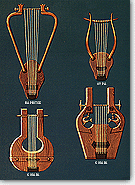



   | |
|
|
Lyric poetry is one of the three great genres of ancient Greek poetry, whereas the other two are the epic and drama. As a category is seems that it existed before epic, but, when we talk about lyric poetry in ancient Greek literature, we usually mean the melodized poetry that developed between |  |
These changes are reflected in the poetry of the period. The praise of kings passes gradually into the area of the myth and with the appearance of new centres of power new traditions are created. The particularity of each individual is highlighted and everyday events such as joys, sorrows and worries of ordinary people, are transformed into tanjible phenomena. Moral values such as justice, equality before the law and caution become an object of poetic negotiation and are used as argumentation for political propaganda. More complicated melodies and rhythms reinforce poetry, and at the same time its eponymous creators increase.
The efforts to classify lyric poetry commence from the time of Plato and the more common criteria that were used are the number of writers, the genre of musical accompaniment, the poetic metre and the thematology. Elegy, iamb and melody can be distinguished by the metre, the context and the style. Finally, with the number of writers as a criterion we have the division of lyric poetry into monody and choral lyric song.
|
| |
|
Note: Click on picture for short description. | |